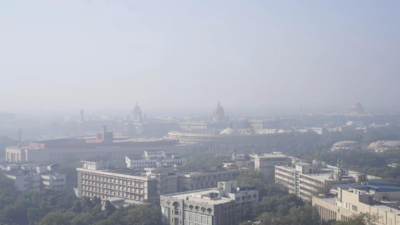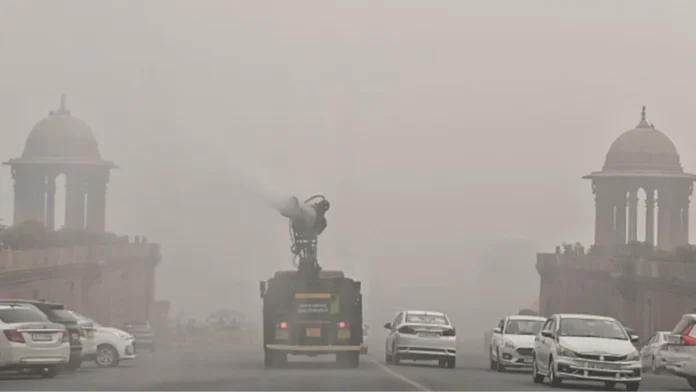GRAP IV Restrictions Lifted: The Centre’s panel on air quality revoked Stage IV restrictions under the Graded Response Action Plan (GRAP) in Delhi-NCR on Tuesday following significant improvement in air pollution levels. The Air Quality Index (AQI) recorded a 24-hour average of 369, prompting the withdrawal of restrictions and signaling a positive change due to favorable weather conditions.
Improvement In Air Quality
The decision to lift Stage IV restrictions under GRAP was based on substantial improvement in Delhi’s air pollution levels. Over the past weeks, Delhi experienced a sharp decline in particulate matter levels, credited to improved weather patterns, stronger winds, and coordinated efforts to reduce emissions.
Stage IV restrictions are the most stringent under GRAP and include measures like halting construction activities, restricting the use of diesel vehicles, and limiting industrial operations. The rollback of these measures signals a respite for industries and residents alike, who have endured severe curbs in their daily activities.

What Is GRAP?
The Graded Response Action Plan is an emergency framework devised to tackle air pollution in Delhi-NCR. It categorizes pollution levels into various stages—moderate, poor, very poor, severe, and severe-plus—each triggering a specific set of actions.
Stage IV restrictions are implemented during the severe-plus category, where AQI levels cross 450, making it hazardous for all individuals. In such cases, stringent measures are adopted to control further deterioration of air quality.
Current Air Quality Scenario
Delhi’s AQI, recorded at 369 on Tuesday, falls in the “very poor” category but is a marked improvement compared to the “severe” and “severe-plus” levels seen earlier this winter. Favorable meteorological conditions, such as stronger winds dispersing pollutants, played a significant role in reducing pollution levels.
The improvement in air quality has also been attributed to strict implementation of GRAP measures over the past few months. Authorities imposed bans on construction activities, restricted vehicular movements, and enhanced monitoring of industrial emissions during periods of heightened pollution.

Relief For Residents And Industries
The lifting of Stage IV restrictions comes as a relief to various sectors in Delhi-NCR. Construction projects, which were halted under GRAP, can now resume operations, providing much-needed employment and economic activity. Similarly, industries restricted from using diesel-powered machinery can now operate without hindrance.
Residents, too, are breathing a sigh of relief as restrictions on vehicular movement are eased. Public sentiment reflects optimism about the possibility of enjoying the winter season with relatively cleaner air compared to previous years.
Challenges In Managing Delhi’s Air Pollution
Despite the temporary improvement in air quality, Delhi’s pollution remains a recurring challenge. The city’s geographical location, coupled with industrial emissions, vehicular pollution, and agricultural stubble burning in neighboring states, contributes significantly to the air quality crisis.
Over the years, the government has introduced various measures, including GRAP, to combat the problem. While these efforts have shown results, experts argue that a long-term solution requires better infrastructure, stricter regulations, and greater public awareness.
Historical Trends In Air Quality Management
Delhi’s battle with air pollution is not new. Each year, the onset of winter exacerbates the problem, as colder temperatures and stagnant winds trap pollutants closer to the ground. The National Capital Region frequently records AQI levels in the “severe” category, prompting emergency measures like GRAP.
Previous instances of lifting restrictions under GRAP have also been linked to short-term weather improvements rather than sustained pollution control measures. For instance, similar decisions were made in the winters of 2021 and 2022 when strong winds helped disperse pollutants, providing temporary relief.

Public Response To The Decision
The withdrawal of GRAP Stage IV restrictions has been met with mixed reactions. While industries and businesses have welcomed the move, environmentalists caution against complacency. Many experts emphasize the need for continuous efforts to maintain air quality and prevent a relapse into severe pollution levels.
Citizens, on the other hand, have expressed hope that the improvement in air quality marks the beginning of more sustained efforts to combat pollution in Delhi-NCR. Social media platforms have been flooded with discussions on the effectiveness of GRAP and suggestions for long-term solutions.
Need For Sustainable Solutions
While GRAP remains an effective emergency response mechanism, tackling Delhi’s air pollution problem requires sustainable and holistic solutions. Experts suggest the following measures:
- Promotion Of Renewable Energy: Transitioning industries and households to cleaner energy sources can significantly reduce emissions.
- Enhancing Public Transport: Investing in efficient and affordable public transport systems can reduce vehicular emissions.
- Tackling Stubble Burning: Coordinating with neighboring states to provide alternatives to stubble burning can address one of the major sources of winter pollution.
- Urban Greenery: Expanding green cover in urban areas can help absorb pollutants and improve air quality.
The Road Ahead
The lifting of GRAP Stage IV restrictions is a welcome step, but it serves as a reminder that Delhi’s air pollution crisis is far from over. While immediate relief is a cause for celebration, the focus must remain on implementing long-term solutions to ensure cleaner air for the residents of Delhi-NCR.
The improvement in air quality this winter highlights the potential impact of coordinated efforts and favorable weather. However, maintaining this momentum will require continued vigilance, strict enforcement of pollution control measures, and proactive policy interventions.
As Delhi breathes slightly easier, the hope is that the lessons learned this season will pave the way for a future where clean air is the norm rather than an exception.

